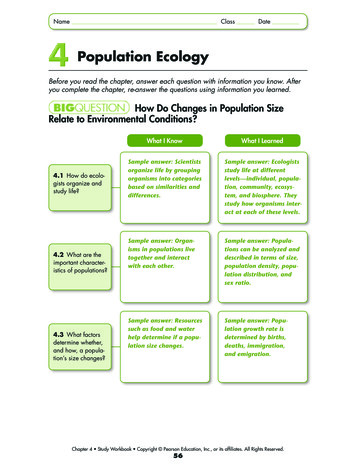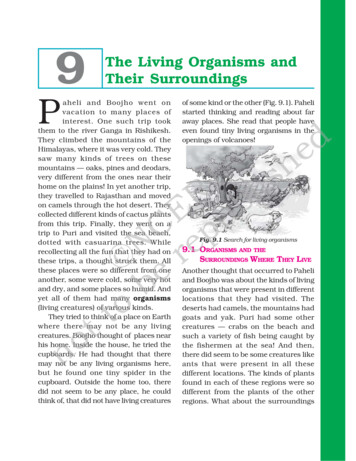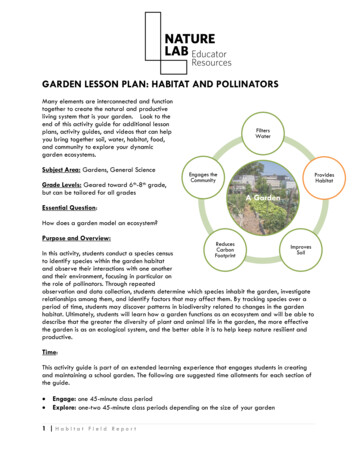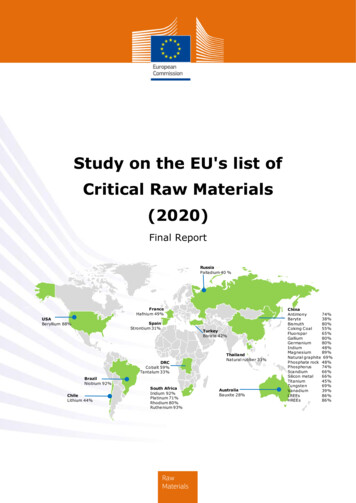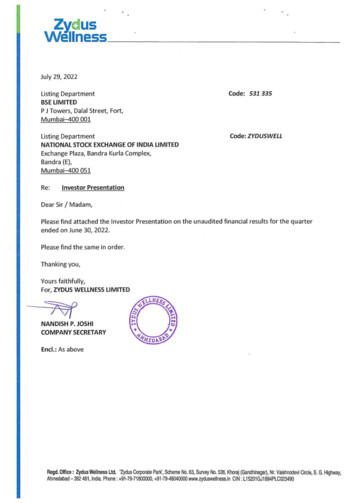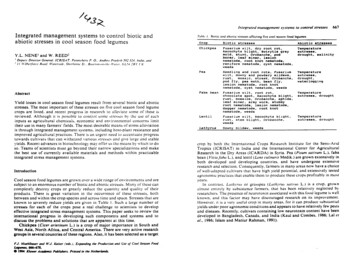
Transcription
h t i * g r u t i trtcrrtrlgcDr.r,lcrur/sjq.srctrtst uIntegrated management systems to control biotic andabiotic stresses in cool season food legumes-TI 1-IntroductionCool season food legumes are grounnover a w'ide rnngc ofcnvironmcnts and aresubject to an enornlous nunibcr o f b i o t ca n d abiotic strc scs.M ; t n o l ' t h s ecancompletely destroy crops o r greatly r*educc thc cluantlty and quality of' theirproducts. There is great variation In thc occurrence of thcsc strcsscs, bothbetween and within the crop species and across tirllc and space. Strcsscs that areknoivn to sc\.erely reduce yields arc pivcn in Tablc 1 . Such rr lrrrgc number ofS FCSSC'S for each of the crops pose a real challenge to scienttats to developeffective integrated stress management systems. This paper seeks to review theinternational progress in developing such components and systerns and todiscuss the problems and solutions that are apparent at this time.Chickpea (Cicer orietinun L.) is a crop of major importance in South andWest Asia, North Africa, a n d Central America. There are very active researchgroups in several countries of these regions. Also, it has been selected a s a targetF.J. Muahfbnuer and W.J. Kaiser (eds.), Expru dingthe Pruducriun und Use Y A C S666-678.0 1984 KIuwcr A c W c Publthhers. Printed in the Netherlaeds.UJ COO/SeusunF d-CropBiotic stressesA b i o t i c stressesChickpeaPusarium w i l t , d r y r o o t r o t ,Ascochyta b l i q h t , B o t r y t i s graym o l d , s t u n t , O r o b a n c h e , podb o r e r , leaf m i n e r , lesionnematode, r o o t k n o t nematode,r e n i f o r m nematode, c y s t nematode,weedsTemperatureextremes,drought, s a l i n i t yPeaS e e d l i n g and r o o t r o t s , Fusariumw i l t , downy and powdery m i l d e w s ,rust,mosaic, s t r e a k , Orobanche,pod f l y , pea moth, bean f l y ,l e s i o n nematode, r o o t k n o tnematode, c y s t nematode, weedsTemperatureextremes,drought,waterloggingFaba beanFusarium w i l t , r o o t rot,c h o c o l a t e s p o t , Ascochyta b l i g h t ,r u s t , mosaics, Orobanche. aphids,l e a f m i n e r , army worm, s t u b b yr o o t nematode, l e s i o n nematade,d a g g e r nematode, r o o t k n o tnematode, w e e d sTemperatureextremes, droughtLentilFusarium w i l t , A s c o c h y t a b l i g h t ,r u s t , s t e m b l i g h t , Orobanche,weedsTemperaturee x t r e m e s , drouqhtLathyrusDowny m i l d e w , weedsD ptrr,r5irrc.ror Grrrerrrl, lCRlSA T. Pnlrorc.lrcrrc P. 0.lrtc//rltrtr Prork-rlr 502 324. /littin. rrrrclI l If 'illrr-t:fi ltrc r.Roircl. If'trrt r.titk .Slrc*r.hr r/ t S t . . B o i r t r - o t r -Irf l;rrt4r. l - CiL.74 R 1' I 'h'Yield losses in cool season food legumes result f'ron several biotic and abioticstresses. T h e most important of these strcsscs on five cool season food legu necrops are listed. and recent progrcss in rcscnrch to allu\,inte some of thcsc isre\.ie\ved. Although i t i s possiblc to control somc atrcsscs b!. thc usc of suchSinputs as agricultural cllemicals, economic and C I I \ . I - C I I I I I C ICI O I C C I Ili171ittheir use in many farmers' fields. Thc most desirable means of stress alleviationis through integrated managcnicnt systems. including host-plant resistance andimproved agricultural practices. There is a n urgent nccd to accentu;itc progrcssto\\rards cultivars that can .ithststnd\,arious strcsscs and give largc iind stableyields. Recent advances in biotechnolog .ma!' o f k r u s thc means by nfhich to d oso. Teams of scientists must go beyond their narroN- specializations and makethe best use of currently available materials and methods within practicableintegrated stress management systems.667Rtot cand a b o t l cslrcsscs afrcct ngfivc cool w a w n food lceumcsY.L.NENE1 and W. REED2Abstractc o n t r stresseslcrop by both thc Intcrnational Crops Kcscurch Institute for the Semi-AridTropics (ICKISAT) in India and the International Uentcr for AgriculturalResearch in the Dry Areas (ICARDA) in Syria. Pea (Pisum sativun L.). fababean ( Vicicrji hrtL.), and lentil (Lcns c.uliriuris Medik.) are grown extensively inboth developcd and developing countries, and have undergone exrensivcresearch and selection. Consequently. f'arrnurs in many areas now have a choiceo f well- rdnptcdci ltivarsthat have high yicld potential, and extensively teslcdrigronornic. prirctices that cnablc them ti? prt ducr:these crops profitably in rnostvc;irs.I n contrast. L r r r l r r orc . grasspea (l. r /tj-r.rt.sst ti\.lc.\- L.) is a crop, grown;rln osrcnt rclyby subsistcncc t'rirrncrs, that has bccn relilrivcly neglcctcd b!.rcscarchcrs. Thu prcscncc of n c r o t o x ussociatcdinwith this food legume is \ .ellk n o w n . and this ('actor may have discouraged rcscarch on its irnpro\,ement.I-iowcvcr. i t is ;i very iiscl'ul crop in many areas. for i t can producc substantialyields under poor agronomic conditions and appears to have relatively few pestsand diseases. Kecently, cultivars containing low neurotoxin content have beendevelopcd in Bangladesh. Canada, and India (Kaul and Combes. 1986; Lal eluI., 1986;Islam and Matiur Rahman, 1991).
Components of Integrated Stress Management SystemsThe productivity of any crop is dependc it11po11a large nunibcr o f cornponcntsof the systcrn in ivhich i t is grn\ .1i. Mast stscss nlnn;lgcn1c1it ini t i l l ti\.cs interact\\.it11 nlany ofthcsc C O I I I O I I I I;111d S , \\,it11 each otlicr. 11111st, rllilst c\.cr tu;tllybcconsidered and tcsted as integrated inputs u.ithiri the crop s!rstcn .riitt crthan assinlple add-on factors.Tlic primary cvnlponcnt incrop i s tllc pli111t gcnc t!,pc t h ; of't'nrs litili tlcssrcscarch opportunities to CSOP ittlpro\,c111 1lfscicrlfists. 1.l'r.c thci-c ; s cop c rturiitics.not o tl! I'or the plalit brccrjcr-x to il1csciisc ;I crop's hi sicyicldpotential bur also, and perhaps more importantlj,. 1c.t incrc;isc ttic crop's gcneticresistance to the many yield-reducing factors that h a w to bc faced in farniinpsituations. As the climatic. edaphic, and biotic thrcats to cool senson legumesvary greatly across the \\'idt' gcograpliic ratlgc o\.cr u.hic11 thcy arc gso\sln, i t i si rlpvssible to design a gcnotypc that will be idcal for all cn\lironn crrts.Consequently, it niust be accepted that tllc rnrtjor itgrn-ecological zones willrequire differins genotypes of each Icguriio crop.Each gcnotypc uftcn rcquircs its a\s.n. spccii llj'dcsigncd. agri lioniic packageof practices that ivill cni hlci t to bc psofirirbl!. espioitcd \ ithiri i t 5 a d i l p t ; t i L I I T iC i. I! 1 01. C L I I I I \ ;it11)1i.h i , ) \ \ I I I P L \ I C ii11d,O I I C I ' i \ t , l l I TII 'l i IIL I C Cill1Sinteract to infliicncc b i t ;111di c ; I-Jioficsirc 5sc3;I tlci c .ijp1i 1 1 5 .Idci lt!,. ; i n optiriii mj7ii 'hiig .o1' :r'opgcnl.)t! pc allti :igrorlonIIc s!,z1cSln s1)ouIrlbc dc\,clopcd for ci chioc;iricr .but [his 1 5 c.lc;ri.l! i l o PC I.II;I -J\s i l ? l tllc. t cbthat can be acllic\.ccj \ .ill he tilt d c c I t - r ol'\il c irlci!l t ;tciicj lt:if gct c. t!17 3.\i,itllhixxific ;igror or icr - c c o r i iot xc ].or ltllci t t 1111'1'c:1 i1ig;LI.C;I\ o \ CI. 1i.111 11tt c) illbc pruu.n. I'or cxamplc. t l l C I I I so\\ingL I I I I tiale a lcipiani spacillg 1.01. such iti .idtlgadapted cultivar may di1ti.1. across thc r a n g 01' boil !,pcsa n d c l i a t e swithin its zone of adaptation. and differing csop protcction 1ncasurc.s ma), bcrequired to c o n b a tthe !icld-reducing strcsscs .hcrctlltsc a1.c I.OLIIIJto belocr. tion-spccillc.Allernitti\;ely. i t night be morc produurivc I O sclcct ;I ran2c ot'pcr oiypcstcrsuit the level ol'agronomic i r l p thatt s call bc ilff' rdcdb!, 1110 l drrncrsin aspecific zone. A high-!.iclding l l t i \ ' i t lth; t.\ 'ill !,icld i\'cll i .hcn prixiclcd with L I S C I inpi ts I C C:III hc pro\,idcd I'ol' those l'a l.nlc1.5 \ \ , l i Lr ' ; I I ;I I'l.i) .d I I c M c' .I I Ca culti\'ar wit11 less yic1J potential b i itt ith rcsist; ncc nlodc -a e c s i s t u to thecclocally doriiinant srresses rniyht be morc usct'ul to the t'iinncrs ijho cannot utilizesuch inputs.Although immunity. or very strong resista ceto pcsts arid discascs would bedesirable. it is much morc likely that lower Ie\.cls of' rcsislancc or tolerance willbe more easily found. This seems truc in casc of faba bean where only moderatedegrees of resistance to Botr.) lisr-inor uPers.:Fr. and B. j i r h Sardinaearea\tailablc. and therefore cffectivc management would involve use of biologicaland nlinin alchemical means (Harrison. 1988). Many landrace cultivars arcfound to h a t e evolved such protection against locally damaging strcsscs. I t iscsscnti;ll to cnsilrc that thc improved cultivars dcvclopcd to rcplacu suchI i i f c f r :;irei not nlorc susccptiblc than thcy arc. urilcss thc local hrmcrs 1ii11.cthe ability to irsc altt'rnatit'c means ol' pest control. For cxamplc. no ncwchickpca cultivar can succccd it1 peninsular India unlcss it has bcttcr Iei.cls olrcsistancc io t.'l s; sii ii\ t i l t . clr!. root rot. coll; rrot. and l/(*/ic,rrlv,r l)r/ ii.)rri,cc,i.(/( 1 i i i h ) I ; I I the Ioc;11 I ; I c ; I c c ' For. CX IIIIPIC.thc t';\b; bc;111 I L H I8 l i . allcsucllcnr loci11 I; tidr;l cin Syrra and I.cb;inon. c;rn bc crossed \ t h B lrt., ti.\rcsis ;intf3f'L 201. to impro\.c its ; cucptab liry(Mallha, IYX.7).The growth and yiclci vf'a crop genotype will be af'fcctcd by all thc compnnctitsof an agronomic pilckagc. 1.e. primary cultivation, sowing, spacing. wccding.soil fertility cnhanccmcnt. and so11n oisturccontrol. C'hangcs in a n y of thcsccomponents can also have major consccjucnccs on the lcvcls o f strcsscs, l i n k 1their ef'fects on the crop. For cxamplc. Jclaying sowing date and incrcasinsplant population significantly rcduccd taha bcan root rot [j.ir.vrrrrlrr r.\ollirri(Mart.) Sacc. 1'. sp. ./irhtir*] and ir.ilt (I.'. o.\.!.\j orrorrSctilcchtcndahl insidc!lcc(Siilill a1111 Asech. li1Si). 111 I l c l i ; elcl ccl,\ou.ing 01' c h c h p c . rci1 1icitI X S r) . t l ; ! s O \l\ l l l g; I S C O C I J , I , I 1 7 1 1 i l\ t L I # 1 1 \ ) L L I L I L, .I C I ( ' I I Y I [ J , I I I I (11, I.CL!LICCLI 1301 r! 11, gr; ! I I I O I 01' , I l c h pI 11 :\ i c I I ( K i r . ht , / ( I / . . 10s') 1.T-IIc . r o p111i1st110t t- c .011\1dcrtt1111 I , \ O ; I I I OI'OI.I I .i t 3 ! L I \ I ; I O \ I I O I I 1 1 11 i c i g k t oL rI O , C LgI I I II;I\C III;I,IOI, LSI' .CL,I\ L ) I I t l cl i o p i l i t 01'o \io\ n cpc\t,.I I I O I I C . \ !IICII; \ I 1 t l cI ; I I I C 111\ ; I I I J r C i I \ )I! ;Ip rtici I; rl